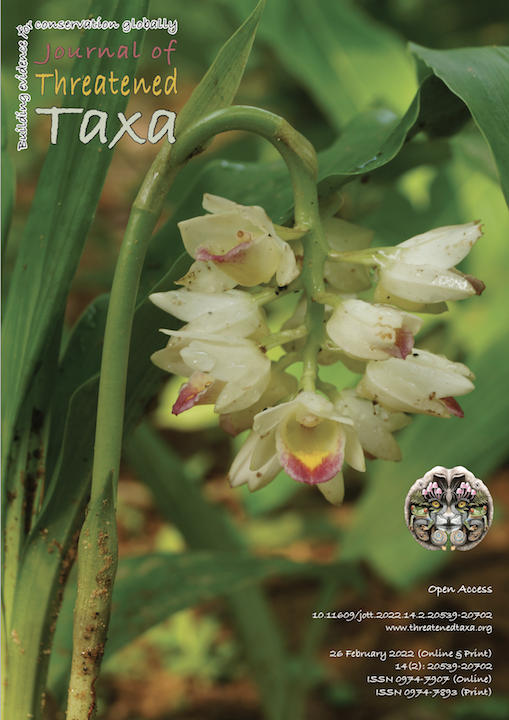Rediscovery of Platerus pilcheri Distant (Hemiptera: Reduviidae), a forgotten assassin bug from India, with comments on its range extension
Main Article Content
Abstract
Platerus pilcheri Distant, 1903, a harpactorine reduviid, is rediscovered from India after more than a century since its original description. A brief diagnosis of this species, a note on its range extension, a distributional map, and images of live habitus are provided along with the images of a syntype preserved in the Natural History Museum, London (BMNH). We also present a comparison with the other Indian congeneric species, Platerus bhavanii Livingstone & Ravichandran, 1991, and show that this latter species does not belong in the genus Platerus and is to be treated as species inquirenda. The issue of the subsequent documentation of Platerus bhavanii from Karnataka is also discussed.
Article Details

This work is licensed under a Creative Commons Attribution 4.0 International License.
Authors own the copyright to the articles published in JoTT. This is indicated explicitly in each publication. The authors grant permission to the publisher Wildlife Information Liaison Development (WILD) Society to publish the article in the Journal of Threatened Taxa. The authors recognize WILD as the original publisher, and to sell hard copies of the Journal and article to any buyer. JoTT is registered under the Creative Commons Attribution 4.0 International License (CC BY), which allows authors to retain copyright ownership. Under this license the authors allow anyone to download, cite, use the data, modify, reprint, copy and distribute provided the authors and source of publication are credited through appropriate citations (e.g., Son et al. (2016). Bats (Mammalia: Chiroptera) of the southeastern Truong Son Mountains, Quang Ngai Province, Vietnam. Journal of Threatened Taxa 8(7): 8953–8969. https://doi.org/10.11609/jott.2785.8.7.8953-8969). Users of the data do not require specific permission from the authors or the publisher.
References
Agarwal, A. (2019). Platerus pilcheri. Photographs found on iNaturalist (Online database). Last accessed 10.vi.2021. https://www.inaturalist.org/observations/36775123
Ambrose, D.P. (2006). A Checklist of Indian assassin bugs (Insects: Heteroptera: Reduviidae) with taxonomic status, distribution and diagnostic morphological characteristics. Zoos’ Print Journal 21(9): 2388–2406. https://doi.org/10.11609/JoTT.ZPJ.871.2388-406
Bhagyasree, S.N. (2017). Taxonomic studies on assassin bugs (Hemiptera: Reduviidae) of South India. PhD Thesis (Unpublished). Department of Agricultural Entomology, University of Agricultural Sciences G.K.V.K, Bengaluru, 334pp. Last accessed 10.ii.2022. http://krishikosh.egranth.ac.in/handle/1/5810042458
Biswas, B., G.C. Sen & L.K. Ghosh (1994). Insecta: Hemiptera: Reduviidae, pp. 369–411. In: Ghosh, A.K. (Ed.). Fauna of West Bengal. Part 5. Insecta: Hemiptera. State Fauna Series 3. Zoological Survey of India, Kolkata.
Biswas, B. & B. Mitra (2014). Checklist of Indian assassin bugs (Insecta: Hemiptera: Reduviidae). (Online Document) Last accessed 20.ii.2022. http://indiabiodiversity.org/document/show/302?pos=
Distant, W.L. (1903). Rhynchotal Notes. XVI. Heteroptera: Family Reduviidae (continued), Apiomerinae, Harpactorinae and Nabinae. The Annals and Magazine of Natural History 11(63): 245–258. https://doi.org/10.1080/00222930308678761
Distant, W.L. (1903–1904). The Fauna of British India, including Ceylon and Burma. Rhynchota, 2 (Heteroptera). Taylor and Francis, London, UK, 503 pp (pp. i-xvii + 1–242, 1903; pp. 243–503, 1904).
Ishikawa, T & T. Naka (2016). The assassin bug genera Nagustoides and Stenolemus (Hemiptera: Heteroptera: Reduviidae) newly recorded from Japan. Zootaxa 4161(4): 593–600. https://doi.org/10.11646/zootaxa.4161.4.12
Kaulback, R (1934) Tibetan Trek. Hodder & Stoughton Limited, London, 300 pp.
Livingstone, D. & G. Ravichandran (1991). A new species of Platerus Distant (Heteroptera: Reduviidae: Harpactorinae) from southern India. Journal of Entomological Research 15: 274–276.
McGrath, T.E. (2003) A Warlord Frontier: The Yunnan-Burma Border Dispute, 1910–1937. Ohio Academy of History Proceedings 2003, 7–29..
Miller, N.C.E. (1954). New genera and species of Reduviidae (Hemiptera-Heteroptera). Commentationes Biologicae 13(17): 1–69.
Schuh, R.T. & C. Weirauch (2020). True bugs of the world (Hemiptera: Heteroptera), classification and natural history (II Edition). Siri Scientific Press, Monograph Series Vol. 8. Manchester, UK, 767 pp. (with 32 color plates).
Stål, C. (1859). Nya slägten och arter bland Reduvini. Öfversigt Af Kongl. Vetenskaps- Akademiens Förhandlingar 16(8): 374–378.
Zhao, P., W. Cai & D. Ren (2006a). The reduviid genus Nagustoides Miller (Heteroptera: Reduviidae: Harpactorinae) found in China, with description of a new species. Zootaxa 1176: 17–25. https://doi.org/10.11646/zootaxa.1176.1.2
Zhao, P., C. Yang & W. Cai (2006b). First record of the genus Platerus Distant (Heteroptera: Reduviidae: Harpactorinae) from China, with the description of a third species of the genus. Zootaxa 1286: 23–31. https://doi.org/10.11646/zootaxa.1286.1.3

